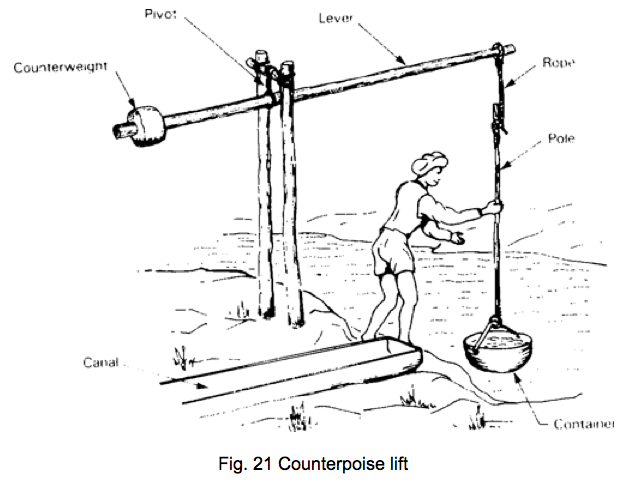Difference between revisions of "Counterpoise lift"
From Akvopedia
| Line 1: | Line 1: | ||
[[Image:counterpoiseLift.jpg|thumb|right|300px|A counterpoise lift. Drawing: FAO.]] | [[Image:counterpoiseLift.jpg|thumb|right|300px|A counterpoise lift. Drawing: FAO.]] | ||
| − | Also known as ''dhenkli'' or ''picottach'', the counterpoise lift is generally used for lifting | + | Also known as ''dhenkli'' or ''picottach'', the counterpoise lift consists of a long wooden pole and is generally used for lifting water from unlined wells, streams or ponds and for irrigating small fields. A weight, often a large stone or a ball of dried mud or a basket filled with small stones is fixed at the shorter end of the pole to counterpoise the weight of a filled bucket which is attached to the longer arm of the pole with a rope. The bucket is emptied by a sideways tipping motion. This device is used to lift water up to a height of 1 - 3 metres. About 2000 1itres of water can be lifted from the depth of 2 to 3 metres in one hour. |
==Suitable conditions== | ==Suitable conditions== | ||
| Line 14: | Line 14: | ||
==Acknowledgements== | ==Acknowledgements== | ||
* [http://agricoop.nic.in/dacdivision/Machinery1/chap7.pdf Water lifting devices.] Agricoop.nic.in | * [http://agricoop.nic.in/dacdivision/Machinery1/chap7.pdf Water lifting devices.] Agricoop.nic.in | ||
| + | * [http://www.google.com/url?sa=t&rct=j&q=&esrc=s&source=web&cd=22&ved=0CDAQFjABOBQ&url=http%3A%2F%2Fwww.inseda.org%2FAdditional%2520material%2FCD%2520-%2520Agriculture%2520and%2520Environment%2520Education%2F38-Farm%2520Machinery%2520%26%2520Implements%2520%28FMIS%29%2FWater%2520Lifting%2520Devices-262.doc&ei=xqOgT4OUEvLXiQLjn8C_Ag&usg=AFQjCNH78PUUOsJ6l48AAdsaY_Vvwpyjcg&sig2=omUG4MOPxaWmynJ5pAddAQ Water lifting devices.] Inseda.org | ||
Revision as of 04:31, 2 May 2012
Also known as dhenkli or picottach, the counterpoise lift consists of a long wooden pole and is generally used for lifting water from unlined wells, streams or ponds and for irrigating small fields. A weight, often a large stone or a ball of dried mud or a basket filled with small stones is fixed at the shorter end of the pole to counterpoise the weight of a filled bucket which is attached to the longer arm of the pole with a rope. The bucket is emptied by a sideways tipping motion. This device is used to lift water up to a height of 1 - 3 metres. About 2000 1itres of water can be lifted from the depth of 2 to 3 metres in one hour.
Contents
Suitable conditions
Construction, operations and maintenance
Costs
Field experiences
Reference manuals, videos, and links
Acknowledgements
- Water lifting devices. Agricoop.nic.in
- Water lifting devices. Inseda.org

